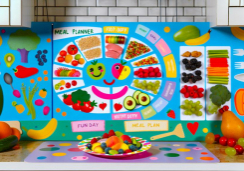5 Key Meal Strategies for Diabetes Control
Imagine you've just been diagnosed with diabetes and you're sitting across from your dietitian, discussing the changes you'll need to make to your eating habits. As you jot down notes, you're told that balancing macronutrients isn't just a suggestion—it's a necessity for maintaining stable blood sugar levels.
You'll learn how to fill your plate with the right proportions of non-starchy vegetables, lean proteins, and whole grains, but that's just the beginning. Consistent meal times, portion control, and choosing low-glycemic foods also play crucial roles in your new dietary strategy.
You might wonder how fiber fits into this picture or why it's important to monitor the types of fats in your diet. As you consider these facets of meal planning, you realize that each strategy could be a key to unlocking better health and diabetes control.
Stay with me as we explore how these seemingly simple steps can transform your daily routine and provide you with a sense of empowerment over your condition.
Balance Macronutrients Carefully
To effectively manage your blood sugar levels, it's essential to balance your intake of carbohydrates, proteins, and fats at each meal. Carbohydrates, particularly healthy carbohydrates with a low Glycemic Index, are crucial in modulating blood sugar levels. By choosing non-starchy vegetables and whole grains, you'll be selecting carbs that have a more gradual impact on your glucose levels. However, it's not just about the type of carbohydrate but also the portion sizes that play a significant role in maintaining stable blood sugar throughout the day.
Integrating proteins and healthy fats—especially monounsaturated and polyunsaturated fats—into your meals can help slow the absorption of carbohydrates, leading to a more sustained release of energy and preventing spikes in your blood sugar levels. Prioritize lean protein sources and moderate your consumption of fruits, dairy, and fats to ensure a well-rounded meal.
For a tailored approach to meal planning in a Diabetes Diet, consider consulting with a registered dietitian. They can assist you in creating a personalized plan that aligns with your dietary preferences and medical needs while carefully balancing macronutrients for optimal diabetes management. Remember, careful meal planning is a powerful tool in your diabetes control arsenal.
Schedule Consistent Meal Times
Establishing a routine where you eat at the same times daily is crucial for maintaining stable blood sugar levels, particularly if you're using mealtime insulin. Your daily routine affects blood glucose control significantly, and eating meals and snacks at regular times helps manage your blood sugar more effectively.
Here are some strategies to incorporate into your diabetes meal planning:
- Seek Professional Advice: Consult with your healthcare provider or a dietitian to establish meal times that align with your medication schedule and daily activities.
- Monitor Your Patterns: Keep track of your eating patterns and blood sugar readings to understand how your meal timing impacts your control.
- Plan Your Portions: Pre-determine the sizes of your meals and snacks to prevent overeating, which can disrupt blood sugar levels.
- Avoid Irregular Spacing: Resist the urge to skip meals or consume one large meal at the end of the day, as this can lead to spikes or drops in your blood sugar.
Monitor Portion Sizes
Accurately monitoring your portion sizes with tools like measuring cups and scales is a key step in controlling your blood sugar levels and managing your weight with diabetes. It's easy to underestimate the amount of food you're consuming, particularly when you're hungry. Visual estimation can lead to consuming more carbohydrates than you intended, resulting in higher blood glucose readings.
Remember, a serving of meat should be about the size of the palm of your hand. Until you're familiar with the correct serving sizes, consistently use measurement tools. This habit will support healthy eating by ensuring you're not unintentionally overeating.
The Diabetes plate method can be a useful guide to balance your food choices. This method encourages filling half your plate with non-starchy vegetables, a quarter with lean protein, and the final quarter with carbohydrate-rich foods, which have a more significant effect on blood glucose levels. By using this plate as a template, you'll be more likely to stick to appropriate serving sizes.
Being patient-centered in your approach, prioritize learning these portion control techniques. They're crucial for effective diabetes management. Taking control of portion sizes empowers you to better manage your condition, enhancing your overall health and well-being.
Opt for Low-Glycemic Foods
While consistently using measurement tools helps manage portion sizes, choosing low-glycemic foods is equally essential for maintaining stable blood glucose levels. Low-glycemic foods are crucial in how carbs affect your blood sugar, offering a way to eat healthy without causing rapid spikes.
Here's a list of strategies to incorporate low-glycemic options into your meals:
- Whole Grains Over Refined: Swap out white bread and pasta for whole grain alternatives. Foods high in fiber, like whole grains, have a milder impact on blood sugar.
- Non-Starchy Vegetables: Fill half your plate with non-starchy vegetables. They're packed with nutrients and have minimal effects on your blood sugar levels.
- Legumes for Protein and Fiber: Include beans, lentils, and chickpeas in your diet. Legumes aren't only low-glycemic but also provide protein and fiber, which can help control your blood sugar.
- Fruit Choices Matter: Opt for fruits like berries and apples. These healthy food choices are lower on the glycemic index and can satisfy a sweet craving without leading to a significant blood sugar increase.
Incorporate Dietary Fiber
Incorporating dietary fiber into your meals is a proven strategy to manage blood sugar levels and support overall health. Foods high in fiber, such as nonstarchy vegetables, fruits, nuts, legumes, and whole grains, play an important part in your diabetes management. When you include these foods in your healthy meal plan, they help control your blood sugar by slowing down the absorption of sugars.
Dietary fiber isn't just about blood sugar; it also aids in maintaining a healthy weight and supplies your body with essential nutrients. By choosing fruits and vegetables, you can satisfy sweet cravings naturally, without added sugar—a big win for both your taste buds and your health. Moreover, the fiber from beans, lentils, whole grains, and nuts is crucial for repairing and building tissues, which is vital for overall well-being.
As you practice Carbohydrate Counting, remember that fiber-rich foods have a less immediate impact on blood sugar levels compared to their refined counterparts. Emphasizing fiber can also reduce your risk of heart disease, a common concern for individuals with diabetes. So, make fiber a cornerstone of your meals, and you'll be taking a significant step towards better diabetes control.
Frequently Asked Questions
What Are the Major Dietary Strategies Used for Diabetes?
You'll manage diabetes with glycemic indexing, carbohydrate counting, and nutrient timing. Portion control, whole foods, and a fiber focus, along with balanced macronutrients, anti-inflammatory foods, smart snacking, and sugar monitoring are essential.
What Is the Most Popular Meal Planning Approach Used by Diabetics?
You'll find that carbohydrate counting, coupled with understanding the glycemic index, is a popular approach. It allows for flexible insulin use and emphasizes meal timing, portion sizes, and strategic food pairing for optimal control.
How to Control Diabetes by Food Control?
You can manage diabetes by monitoring your glycemic levels, counting carbohydrates, controlling portion sizes, timing nutrients effectively, reducing insulin resistance, and stabilizing blood sugar with healthy fats, high fiber intake, wise snack choices, and regular meal frequency.
What Are the 7 Steps to Control Diabetes?
To control your diabetes, monitor your blood sugar, exercise regularly, stick to your meds, manage stress, get regular check-ups, stay hydrated, focus on sleep quality, care for your feet, quit smoking, and lean on support networks.
Conclusion
In managing your diabetes, balance your macronutrients wisely, sticking to a nutrient-rich, low-fat diet. Schedule meals consistently to stabilize blood sugar and optimize medication. Don't skip meals; it risks hypoglycemia and poor choices later.
Control your portions using tools for accuracy—your health depends on it. Choose low-glycemic foods and high-fiber options for fullness and blood sugar control.
Remember, a diverse diet incorporating healthy fats supports your heart and overall well-being. Stay informed and proactive in your dietary choices.










